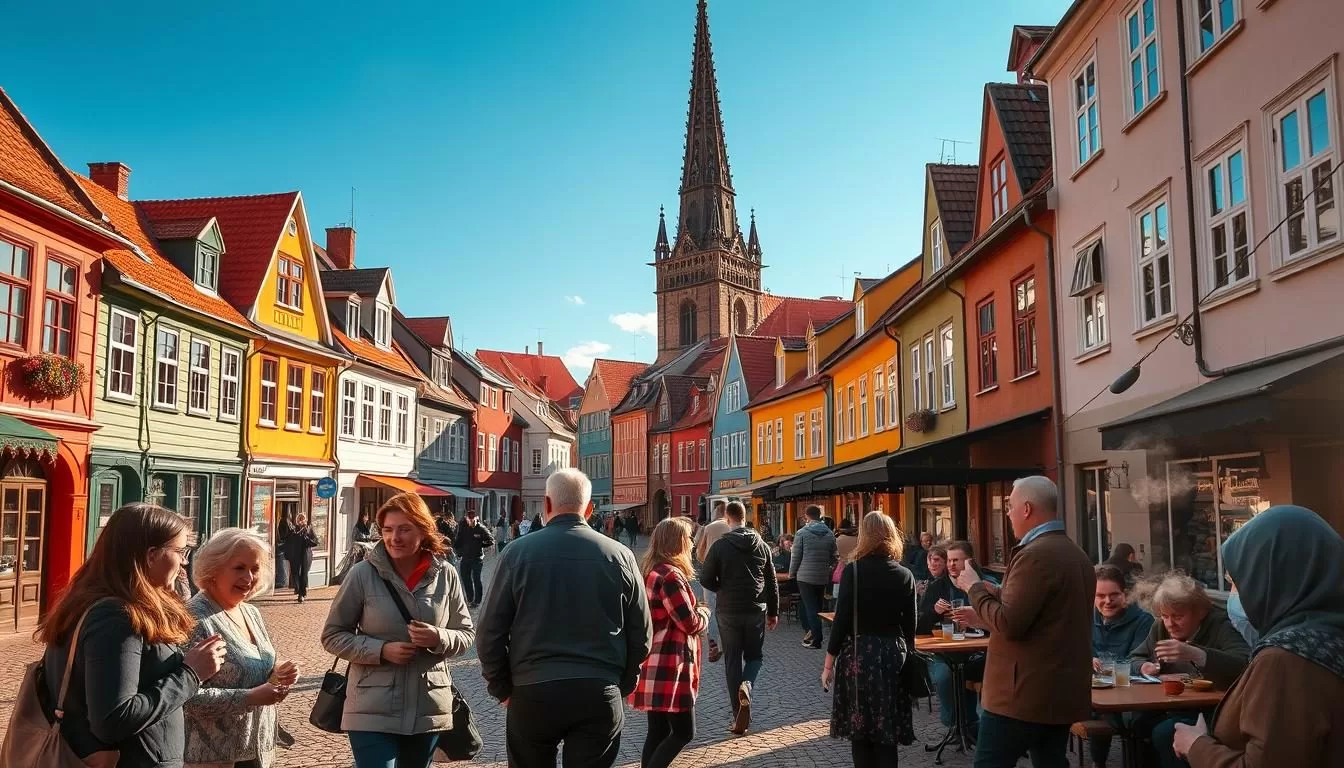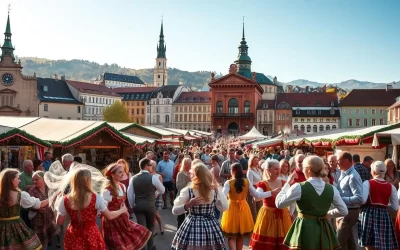Have you ever wondered about the linguistic tapestry of Sweden? This country boasts a rich heritage tied to its primary language, Swedish. Recognized as the official language, it’s deeply rooted in North Germanic traditions, with ties to Old Norse.
Swedish stands out with its unique alphabet, featuring characters like å, ä, and ö. These symbols add a distinct flavor to its written form, blending history with modern usage. Beyond Swedish, the country is home to a vibrant mix of languages, reflecting its Nordic connections and cultural diversity.
With over 200 languages spoken, Sweden’s linguistic landscape is dynamic. Minority languages such as Finnish, Sámi, and Romani also hold significant cultural value. This blend of languages shapes the country’s identity, making it a fascinating area for exploration.
Ready to dive deeper? The next sections will uncover minority languages, demographic trends, and the impact of immigration on Sweden’s linguistic evolution.
Introduction to Sweden’s Linguistic Landscape
The story of Sweden’s language is deeply tied to its Nordic heritage. Rooted in Old Norse, the germanic language has evolved over centuries, reflecting the country’s rich history. From Viking-era runes to modern Swedish, this linguistic journey mirrors societal changes and cultural shifts.

Historical Background and Nordic Roots
Swedish traces its origins to Old Norse, the language of the Vikings. Over time, it developed into a distinct germanic language, influenced by neighboring cultures and trade routes. The introduction of the Latin alphabet in the Middle Ages marked a significant turning point, shaping the written form we know today.
Today, Swedish is spoken by over 10.5 million people worldwide, with the majority residing in the country. Its evolution from ancient traditions to a modern society highlights the resilience of linguistic heritage.
Cultural Significance of Language in Society
Language plays a vital role in shaping societal norms and cultural identity. In Sweden, it’s more than just a means of communication—it’s a reflection of shared values and history. For example, the use of the gender-neutral pronoun “hen” has gained acceptance, showcasing the country’s progressive mindset.
Minority languages like Finnish, Sámi, and Romani also contribute to the cultural mosaic. These minority languages are not only spoken but also protected by the government, ensuring their preservation for future generations.
Sweden: Official and widely spoken languages
Language in Sweden is not just a tool for communication but a legal cornerstone. Swedish, the official language, is deeply rooted in the country’s legal framework. It’s recognized as a north germanic language, with its status entrenched in law since 2009.

This legal recognition ensures Swedish is used in government, education, and public services. It’s also one of the two national languages of Finland, reflecting its regional importance. Over 90% of the population speaks Swedish, making it the majority language.
Legal Rights for Minority Language Speakers
While Swedish dominates, minority languages like Finnish, Sámi, and Romani are protected by law. Citizens in certain regions have the right to use these languages in dealings with authorities and courts. This ensures inclusivity and cultural preservation.
Educational support is also provided. For example, Sámi language schools offer alternatives for indigenous communities. These efforts highlight the government’s commitment to linguistic diversity.
Implications of Official Status
The official status of Swedish shapes everyday life. It’s used in media, legal documents, and public communication. This ensures clarity and consistency across the country.
At the same time, minority language speakers enjoy legally supported rights. This balance between majority and minority languages fosters a harmonious linguistic environment.
| Language | Status | Percentage of Speakers |
|---|---|---|
| Swedish | Official Language | 90% |
| Finnish | Minority Language | 5% |
| Sámi | Indigenous Language | 0.1% |
This table highlights the distribution of major and minority languages in the country. It underscores the dominance of Swedish while acknowledging the presence of other tongues.
Exploring Minority and Regional Languages
Discover the lesser-known languages that enrich Sweden’s heritage. Beyond Swedish, the country is home to a vibrant mix of indigenous and minority tongues. These languages are not just a means of communication but a vital part of cultural identity.

Sámi, Tornedal Finnish, and Other Indigenous Tongues
The Sámi languages, spoken by around 9,000 people, are a cornerstone of indigenous culture in the northern regions. These languages are deeply tied to the traditions and history of the Sámi people. Similarly, Tornedal Finnish, or Meänkieli, is spoken by 40,000 to 70,000 individuals in the northern municipalities.
These indigenous languages are more than just words—they are a bridge to the past. They connect communities to their roots and ensure that traditions are passed down through generations.
Recognized Minority Languages and Their Roles
Sweden officially recognizes five minority languages: Finnish, Meänkieli, Romani, Sámi, and Yiddish. These languages are protected by law, ensuring their use in education, government services, and community life. For example, Finnish is spoken by about 470,000 people, making it the largest minority language.
In schools, children from minority communities have the opportunity to learn in their native tongue. This support helps preserve cultural diversity and fosters a sense of belonging. As one advocate puts it,
“Language is the heartbeat of culture, and preserving it is preserving identity.”
| Language | Number of Speakers | Role in Society |
|---|---|---|
| Sámi | 9,000 | Indigenous heritage |
| Meänkieli | 40,000–70,000 | Regional identity |
| Finnish | 470,000 | Education and services |
These languages play a crucial role in shaping Sweden’s cultural landscape. By supporting minority language speakers, the country ensures that its heritage remains vibrant and inclusive.
Language Demographics and Population Insights
Understanding the linguistic makeup of a country reveals much about its culture and people. In this section, we’ll dive into the numbers behind language use, offering a clear picture of how communication shapes society.
Statistical Overview of Language Use
Swedish is the dominant language, spoken by approximately 90% of the population. English is also widely used, with 86% of people speaking it as a second language. This high level of bilingualism reflects the country’s global connections.
Minority languages like Finnish, Meänkieli, and Romani add diversity to the linguistic landscape. Finnish, for example, is spoken by about 5% of the population, with around 200,000 speakers. These languages are protected by law, ensuring their preservation.
Geographic and Cultural Language Distribution
Language use varies across regions. Urban areas like Stockholm are hubs of linguistic diversity, with immigrant languages such as Arabic and Persian commonly spoken. In contrast, rural regions often maintain traditional dialects and minority tongues.
This uneven distribution impacts language services. For example, educational resources in Sámi are more accessible in northern areas, where the minority population is concentrated. Such efforts highlight the importance of tailoring services to local needs.
| Language | Percentage of Speakers | Region |
|---|---|---|
| Swedish | 90% | Nationwide |
| Finnish | 5% | Northern regions |
| Arabic | 2% | Urban areas |
These statistics show how language use reflects both cultural heritage and modern influences. For more insights into the country’s linguistic diversity, explore this resource.
Influence of Immigration on Sweden’s Language Scene
Immigration has reshaped the way people communicate in Sweden. Over the years, the arrival of newcomers has introduced a variety of new languages, enriching the cultural fabric of the country. Today, you’ll hear Arabic, Persian, and Somali alongside Swedish in urban areas.

Emergence of Immigrant Languages and Community Impact
The rise in immigrant populations has brought a wave of linguistic diversity. In 2015 alone, over 162,000 asylum seekers arrived, many bringing their native tongues. This has led to a vibrant mix of language spoken in schools, workplaces, and neighborhoods.
Communities have adapted to this change. For example, Arabic is now one of the most common languages in cities like Stockholm. This shift has created opportunities for cultural exchange but also challenges in integration.
Language Education for New Arrivals
To help newcomers integrate, the government offers programs like Swedish for Immigrants (SFI). These courses provide essential language skills, enabling immigrants to communicate effectively in their new home.
Children of immigrants also receive mother tongue tuition in schools. This ensures they maintain their native language while learning Swedish. Such initiatives highlight the commitment to inclusivity and cultural preservation.
| Language | Percentage of Speakers | Region |
|---|---|---|
| Arabic | 2% | Urban areas |
| Persian | 1.5% | Urban areas |
| Somali | 1% | Urban areas |
This table shows the growing presence of immigrant languages in Sweden. For more insights, explore this resource on immigration trends.
Learning Swedish: Benefits and Resources
Mastering Swedish can transform your experience in a new country. Whether you’re aiming for career growth or cultural integration, learning the language offers countless advantages. From free government programs to personal enrichment, the journey is both practical and rewarding.
Government Supported Language Programs
The government offers several initiatives to help you learn Swedish. Programs like Swedish for Immigrants (SFI) and Swedish as a Second Language (SaaS) are designed for newcomers and expats. These courses provide essential skills, enabling you to communicate effectively in daily life.
Many universities, such as Lund and Dalarna, also offer Swedish lessons for international students. These include online courses, making it easier to learn at your own pace. With these resources, you’ll gain independence and confidence in your new environment.
Career and Cultural Advantages of Learning Swedish
Learning Swedish can significantly boost your career prospects. Many international companies, especially in tech, list basic Swedish as a job requirement. Proficiency in the language spoken locally also enhances workplace communication and collaboration.
On a personal level, understanding Swedish deepens your connection to the culture. Terms like “fika” and “lagom” have no direct translations but are integral to daily life. As one learner shared,
“Learning Swedish made me feel at home in a way I never expected.”
| Program | Target Audience | Benefits |
|---|---|---|
| SFI | Newcomers | Basic communication skills |
| SaaS | Expats | Advanced language proficiency |
| University Courses | Students | Flexible learning options |
Ready to start your journey? Explore resources like this guide for tips on integrating Swedish into your career. For more insights, check out this resource on the cultural benefits of learning the language.
Conclusion
Exploring the linguistic heritage of this country reveals a rich tapestry of culture and history. Swedish, the official language, is spoken by over 85% of the population, making it the cornerstone of communication. However, the presence of minority tongues like Finnish and Sámi adds depth to the nation’s identity.
Learning the local language offers more than just practical benefits. It fosters cultural integration and opens doors to career opportunities. Programs like Swedish for Immigrants (SFI) make this journey accessible for newcomers.
Immigration has also played a key role in diversifying the language scene. Cities like Stockholm now echo with Arabic, Persian, and Somali, reflecting the vibrant mix of cultures.
To deepen your understanding, explore resources like this study on linguistic influences. Whether you’re learning Swedish or seeking translation services, the journey into this country’s linguistic culture is worth every step.
The above is subject to change.
Check back often to TRAVEL.COM for the latest travel tips and deals.
Here are some Tours & Sightseeing suggestions that might pique your interests!





